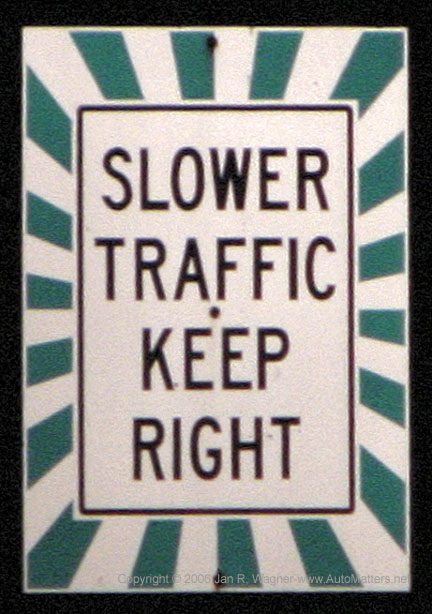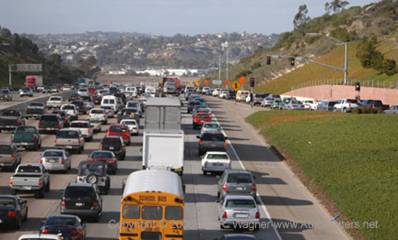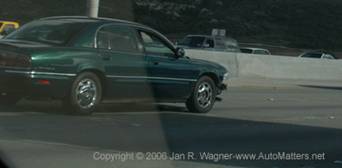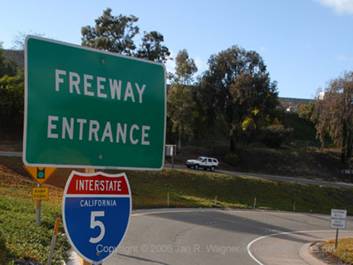
Slower Traffic Keep Right
The past few weeks we have seen stepped-up speed limit enforcement on our San Diego County freeways. My first reaction was to breathe a sigh of relief and think that it’s about time. Too often some cars and motorcycles pass me so quickly on the freeways that it seems as if I am almost standing still. Such a high-speed differential is very dangerous. In such circumstances I have wondered many times where the California Highway Patrol was. So, upon hearing the news of increased speed limit enforcement I welcomed their presence.
It may, therefore, come as a surprise to you that with their increased and, in my opinion, long overdue presence on our freeways, I am about to take issue with what the California Highway Patrol are not doing. I certainly don’t have a problem with their decision to crack down on enforcing (reasonable) speed limits (whether or not our speed limits are reasonable will remain a subject for a different column). My beef is that the powers that be in the Highway Patrol seem to be too selective and arbitrary in what they’ve chosen to enforce.
Compared to where I come from (Alberta, Canada), our freeways in California typically have a lot more lanes – but we also have many, many more people using our roads here. In Southern California there is so much traffic and congestion that at some times of the day, no matter what lane you choose to be in, you might hardly move – and the problem seems to be getting worse with every new year.
However, there are still significant periods of time in most days when the traffic is relatively light. Here’s a case in point. Recently I drove north on I-5 to Los Angeles from San Diego for a business meeting. Traffic was thankfully light but there were vehicles in all lanes. There was a relatively slow vehicle in the “fast” lane so the group of vehicles that I was in passed on the right. The driver in the fast lane seemed oblivious to the other traffic. They neither sped up nor pulled over. Instead they soon disappeared in my rear view mirror. That prompted me to decide to write a column on the subject. By way of research I counted the “left lane bandits” for a few miles.
I began my little freeway test a short distance north of Del Mar and concluded it just before the bottleneck caused by the U.S. Immigration checkpoint. Here is a description of the vehicles and drivers that were maintaining position in the fast lane while other vehicles passed to their right. Most stayed in that lane after they were passed. Bear in mind that traffic was light during my admittedly unscientific study:
- Old pickup truck (male driver) with a load of water bottles
- Volkswagen Passat sports sedan (male driver), with three empty lanes to its right
- Porsche 911 sports car (male driver)
- Taurus SHO high performance sedan (middle-aged female driver), with three empty lanes to its right
- Hyundai Elantra economy car (middle-aged male driver), with three empty lanes to its right and maintaining erratic speeds
- Land Rover Discovery sport utility vehicle (young female driver), with three empty lanes to its right
- Chrysler Concord sedan (middle-aged male driver), with three empty lanes to its right
I was surprised to see the relatively wide variety of cars and drivers in my small, “left lane bandits” study group. I have little doubt that if these slower drivers had moved over into the lanes to their right they would have motored down the freeway just as quickly as they did by planting themselves in the fast lane and causing what I refer to as “moving chicanes.” Their vehicles represented the cones that the drivers of other cars had to maneuver around in order to maintain their desired rate of speed. If the slower drivers had just moved over when they saw faster traffic approaching or, better yet, stayed in one of the right-hand lanes, that would have enabled drivers who chose to drive faster than them to do so more safely – without having to dart in and out, sometimes across multiple lanes of traffic.
“Slower Traffic Keep Right.” This isn’t a new idea. I’ve been driving for about 35 years and for as long as I can remember I’ve seen highway signs that read some equivalent of “Slower Traffic Keep Right” – except, that is, on Southern California freeways. I cannot remember seeing such a sign here. Are there any posted? If so, I am very curious to learn where and about their frequency of placement.
“Slower Traffic Keep Right” is a simple concept, really. When we enter a freeway we usually do so from the right-hand side. If we as drivers adhere to the “Slower Traffic Keep Right” concept, we would really have no reason to change to the next lane over unless a slower vehicle was blocking our path. Since trucks use the two right-hand lanes, and since they typically move more slowly than cars, it is quite foreseeable that drivers of cars might end up having to cross over into the third lane of traffic from the right to maintain their desired freeway speed. At most, however, that is where we should stay – unless there is still slower traffic blocking our progress.
Instead, what typically happens is that a few relatively slow drivers seem to almost automatically move all the way over to the left-hand or “fast” lane as soon as possible after they enter the freeway. I’ve known drivers who do that and it has been impossible for me to convince them to do otherwise. Once there, they stay put until they are ready to exit or until some slower left lane bandit is blocking their path.
But plugging up the fast lane they invariably block drivers who wish to drive more quickly. Impatience inevitably prevails and the faster drivers end up zigzagging from lane to lane, because that is the only way they can maintain their desired speed.
There are a variety of ways people can rationalize getting into the fast lane and staying there, even if they are not moving as fast as some of the other vehicles on the freeways: “Those other drivers want to drive too quickly. I drive fast enough. I am entitled to use the center lane and I am going to stay right there whether anyone else likes it or not.”
Or how about this one: “The fast lane is the safest lane for me to be in because there is a paved shoulder beside me if I need to swerve in an emergency. Since it is safer, that is where I’m going to stay. Anyone who wants to drive faster will just have to drive around me.”
Here’s another: “They are speeders. I do the speed limit so I am legally entitled to stay in whatever lane I want to be in. Speeders have no business driving that fast so I will just ignore them.” Is it the responsibility of a few slower drivers to essentially take traffic law enforcement into their own hands and, in so doing, significantly increase the element of danger on that stretch of freeway? Of course not. Enforcing traffic laws and controlling speeders is the job of the Highway Patrol.
And here’s yet another: “My (fill in the blank) is kind of hard for me to drive. Every time I have to change lanes to pass it is dangerous. I’m going to get all the way over into the fast lane so I don’t have to worry about changing lanes as often. If anyone wants to go around me that’s fine.”
Left lane bandits can really mess up traffic flow.
Whether we like it or not, sometimes people are in a hurry and act accordingly. Right or wrong, and whether it is legal or not, they sometimes make the decision to drive more quickly. If other drivers block them – either intentionally or by being oblivious to their presence, that only serves to compound the situations. In such situations we need to get out of their way, not block them. Ideally those drivers should be using the fast lane, not all four lanes, to pass. Instead, left lane bandits leave them no choice but to weave back and forth between the four lanes in order to maintain their desired speed. If they are driving too quickly the last thing we should do is block them. Instead we should keep out of their way and let the Highway Patrol deal with them. That is their job, not ours.
So, getting back to my original point, a simple concept needs to be taught to all drivers: “Slower Traffic Keep Right.” This should be a subject of an aggressive ad campaign. More signs saying this should be installed on freeways. The Highway Patrol should do a better job of pulling offending drivers over and reminding them to keep right except to pass. We need to recognize that driving too slowly can be dangerous too. Slower is not automatically safer.
Drive safely and do join me again next time.







